Because last year’s Voynich research brought me a step closer to German calendars, I finally got round to reading Ernst Zinner’s epic “Regiomontanus: His Life and Works” (or, rather, to Ezra Brown’s 1990 translation of the same).
On the one hand, Zinner is crushingly magisterial, in both tone and deep attention to detail (though the appendices by other scholars do sometimes highlight Zinner’s occasional dependence on others’ unreliable translations). Yet on the other hand, it is a style of writing characterized by what is clearly a passionate drive to understand Regiomontanus within his cultural, scientific, and mathematical context.
Say what you like about Zinner, but you could never accuse him of skimming the surface of the subject: as the old joke goes, he’s definitely more bacon than eggs (i.e. where “the chicken is involved but the pig is committed”).
Peuerbach and nocturnals
I’ve written a number of times before about how I strongly suspect that the circular drawing on f57v had a ring of letter groups that was originally made up of 4 x 18 symbols, but where the first two letter shapes of each set of eighteen were subsequently joined together into odd gallows-like characters to turn the sequence into a (far more mysterious) 4 x 17 letter-group sequence. Quite why the author did that is not known, but it would seem to me to have been done to conceal the extrinsic 4 x 18 structure.
Why, you may ask, would a 4 x 18 ring be a giveaway? This, in my opinion, is because 360 degrees / (4 x 18) = 5 degrees, which is the kind of explicit marking you would see on an astrolabe-like instrument of some sort. And because one of the secret astrolabe-like instruments of the mid-fifteenth century was the “nocturnal”, “nocturlabe” or “stardial” (astrolabes themselves were hardly secret by that time), I have long wondered whether what was depicted here was this specific instrument.
And so I was fascinated to read the following brief note in Zinner (pp.26-26), in his discussion of Georg Peuerbach (Regiomontanus’ mentor and teacher):
From 1455 on, there existed “stardials” [nocturnals] to tell time at night by means of the Pole Star and two stars {the “pointers”} in Ursa Major.
The footnote reference Zinner gives for this is: “Ernst von Bassermann-Jordan. Uhren. Berlin, 1922. Figure on page 21.” And so I went off (eventually) to have a look for this specific edition.
It turns out that von Bassermann-Jordan was a well-known clock and watch collector, whose classic book (“Uhren”) on the subject was reprinted many times. I was therefore delighted to find out that I could order a relatively cheap print-on-demand copy of the exact same 1922 version that Zinner referenced, and speedily sent off my money.
I must admit to having been a little bit surprised when a padded envelope appeared covered in Indian stamps (I must admit to having wondered whether it was a coincidence that “Uhren” was an anagram of “Nehru”), but that’s globalization for you.
Even though the print-on-demand book cover was really quite nice, the quality of the scans inside was unfortunately more than a little disappointing in places. But even so, I could now try to find what von Bassermann-Jordan said on page 21 that Zinner remarked upon. Sadly, this was one of the many places where the scans became somewhat unrecognizable by the right-hand edge.
Yet because I was able to use Google to search for “Orientierung der Horizontalsonnenuhren” on the same page, this yielded three hits on archive.org, including the 1922 edition I had just bought. (There was also a 1914 edition and a 1920 edition). Unsurprisingly, the 1922 edition was (without any real doubt) the source of the somewhat mangled scans for the Indian POD company, so I can show you what I was trying to read, direct from the source:
Even so, this meant that I was able to find the same thing in the (much clearer, and significantly more readable) 1920 edition of “Uhren”, so that you can hopefully see the structure of the nocturnal (dated “1456”) much more clearly:
I presume that this is referring to the Bayerisches Nationalmuseum in Munich, which (encouragingly) has a collection of scientific instruments. However, I wasn’t able to find the one depicted in its object database (and I suspect Zinner wasn’t able to find it either), but perhaps one of my German readers will have more luck than me. 🙂
Other nocturnals
A very good source for the history of the nocturnal is Günther Oestmann’s (2001) “On The History of the Nocturnal“. Oestmann notes that the idea that the nocturnal was first invented in China has been comprehensively debunked, and that it is instead a European invention – there are no Arabic nocturnals from the Middle Ages. There was also a predecessor to the nocturnal (a sighting tube and disk, described by Pacificus in the 10th century), but the more compact hand-held nocturnal was clearly a far more usable version of the same thing.
The “V2.0” idea of nocturnals had actually been discussed as early as the 12th century (though few seem to have been actually built). Raymon Lull mentions the nocturnal in his Nova geometria (1299), and the device was made famous by Peter Apian’s 16th century printed book:
But documentation on nocturnals between Lull and the 1456 nocturnal noted by von Bassermann-Jordan and Zinner seems quite thin. Oestmann lists all the 15th century nocturnal manuscripts he is aware of, together with references (not included here) to where they are mentioned in Zinner’s (1925) “Verzeichnis der astronomischen Handschriften des deutschen Kulturgebietes“:
* Wolfenbüttel, HAB: Cod. Guelf. 81.26 Aug. 2°, fol. 144v (Use of the Nocturnal, Latin 1461)
* Göttingen, UB: 2° Philos. 42m, fol. 55r/v .00 (Johann v. Gmunden [?], Construction of the Nocturnal, in a collection of astronomical texts, 15th cent.)
* Würzburg, UB: M. ch. q. 132, fol. 153v-154v, 155v (Construction of the Nocturnal, Latin, in a collection of astronomical texts, late 15th cent.)
* Leipzig, UB: Cod. 1469, fol. 201r-207r (Construction of the Nocturnal, Latin, in a collection of astronomical texis, 14-15th cent.)
* Munich, Bayer. StB: Clm 24105, fol.65v-67r (Use of the Nocturnal, German, in a collection of astronomical texts, 15/16th cent.)
* Munich, Bayer. StB: Clm 214, fol. 167r-185v (Construction of the Nocturnal, Latin, in a collection of astronomical tables, 15th cent.)
* Bern, Burgerbibl.: Cod. 157 fol. 27v-28v (Construction and Use of the Nocturnal, Latin, 15th cent.)
* Zürich, Zentralbibl.: Ms. C 107, fol. 107r/v (Wilhelm Hofer, Carthusian monk and pupil of Georg Peuerbach), Construction and Use of the Nocturnal, Latin, Gaming (Lower Austria) 1472/79); see L. C. Mohlberg, Mittelalterliche Handschriften (= Katalog der Zentralbibliothek Zürich, vol. I), Zürich 1951, p.55f., 361).
* Ottobeuren, Klosterbibl.: Ms. II, 319, fol. 122-123 (Construction of the Nocturnal, 15th cent.)
* Meiningen, Landesbibl.: Pd 32.44, fol. 92r-98v, 104r-105v (Construction of the Nocturnal, 15th cent.)
Oestmann also mentions Chartres MS 214 (olim 173; destroyed in 1944), which looked like this, though note that it actually belongs to the earlier “sighting tube” tradition from Pacificus:
But because Oestmann relies on Zinner, who in turn was only looking at astronomical manuscripts within the German cultural orbit, there are doubtless many more to be found. For example, there’s a nice volvelle nocturnal in fol. 25r of MS Ashmole 370, an English manuscript dated ~1424 that I’d really like to see the rest of one day:
If anyone is aware of a better / more recent / more pan-European source on the 12th-15th century history of the nocturnal / nocturlabe than Oestmann, please let me know!
“Stretched out arms”
For Voynich researchers, I would argue that the single most extraordinarily interesting paragraph in Oestmann’s paper is as follows:
Closely connected with the history of the nocturnal are certain diagrams in nautical texts, which served as mnemonic devices for the correction of the measured altitude of the Pole Star. The position of α and β Ursae minoris respectively α and β Ursae maioris, often called ‘Guards’, indicated the correction to reduce the observed Pole Star altitude to obtain latitude. A man with stretched out arms standing in the Pole was used. If the Guards were found over his head the Pole Star stood 3°5′ under the Celestial Pole and vice versa. The two arms marked the side deviations and also intermediate positions were recorded in mnemonic verses.
Given that f57v specifically depicts people with stretched out arms (at the top and the bottom), I suspect that this is an avenue of research that is well worth pursuing further:
Oestmann’s footnote #17 gives as his source:
See for example the Regimento do Norte (probably composed in the 15th century; München, Bayer, StB: 4° Inc., 1551). On the nautical ‘Regiments’ see Joaquim Bensaude, L’astronomie nautique au Portugal à l’époque des grandes de couvertes (Bern, 1912/17, repr. Amterdam 1967), pp. 136-145, 223f.; Hermann Wagner ‘Die Entwicklung der wissenschaftlichen Nautik im Beginn des Zeitalters der Entdeckungen nach neuern Anschauungen’, Annalen der Hydrographie und Maritimen Meteorologie, 46 (1918), pp. 215-220.
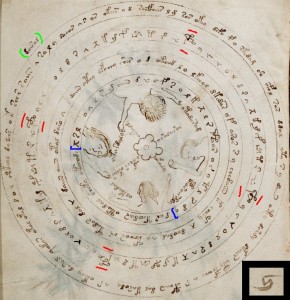
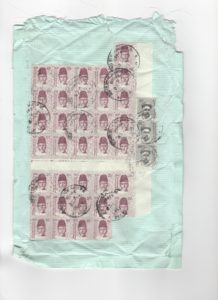
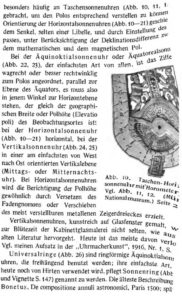
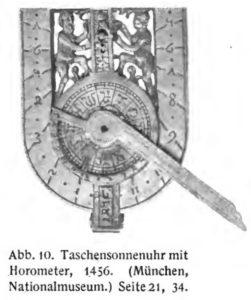
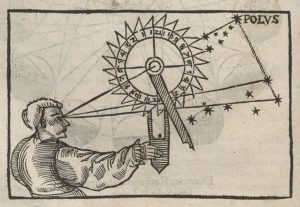
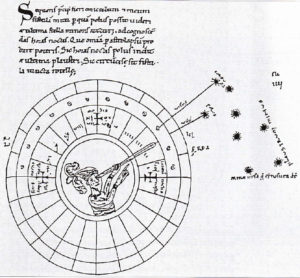

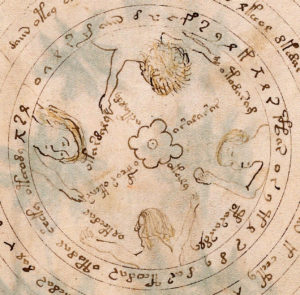
Nick: Very interesting. Well if you can turn this into one of your Block Paradigms then that would be huge.
Nick,
one of the most interesting sources for astrolabes, nocturnals etc. is this one:
http://www.univie.ac.at/hwastro/
Even if it’s not what you’re actually looking for – just enjoy it!
Btw: books and reprints of Basserman_Jordan are available in Germany for reasonable prizes. Just google…
Nick,
I just had a look at the “Objektdatenbank” of the “Bayerisches Nationalmuseum” that holds the Bassermann Collection, but unfortunately the thesaurus doesn’t give me any result. Quite possible that the collection hasn’t been digitized yet. I could send them a query if you want me to do this.
Very interesting blog, Nick.
I spent quite a bit of time looking at sundials, both the horizontal ones and the “wall dials”:
http://c8.alamy.com/comp/CTDDA1/sundial-in-the-stone-wall-of-the-village-church-detordmar-burgos-castlla-CTDDA1.jpg
(A few of the old wall dials sometimes include inverted-T-O themes).
I also looked at many volvelles and daytime marine instruments, but I never explored the “nocturnals”, so I really enjoyed reading this.
Here is another wall-dial from Trentino (a region where the tunic styles were similar to those in the VMS in the 15th century):
http://www.waymarking.com/gallery/image.aspx?f=1&guid=03578ebd-f4b8-49d4-9fa3-e202af37cc41&gid=3
Note the marks around the outer edge and their 2-3 arrangement. One thing that stands out about the VMS in contrast to other manuscripts with cosmological references is the lack of symmetry in many of the rota.
This has always made me wonder if some of the VMS diagrams *might* lean more toward a scientific view of the universe (as it was at the time) rather than a Galenistic simplification of everything into multiples of four.
Very timely !! (OK, sorry, couldn’t resist).
Excellent article which I will study in the morning.
Many thanks !
JP
Bernard Baudoux, Traité du nocturlabe, 2014,
cp. http://www.commission-cadrans-solaires.fr/?p=1681
Helmut: an excellent find, thank you very much indeed, I shall order a copy straightaway… 🙂
Ants. And Nick.
There is no astrolab on that side. There is no astology. Neither alchemy.
On side 57 v. Eliška writes that he has four brothers ! ( 4 brothers).
🙂
Yesterday, I wrote (as usual in a private article) additional info on the center solar pictogram,
and I could not find your old e-mail, but once you (nick) wrote me, that the solar symbol was not in use before 1400. That was a conclusion from a particular researcher. Any idea who and where..?
DavidSch: as I recall, the circle with a dot in it was first used as a sign for the sun (sol) in Florence about 1480, as part of the whole Neoplatonist revival there. I saw this date mentioned in various books on the history of the various astrological signs (I was specifically interested in the history of the Capricorn symbol, which is essentially EVA m), but I don’t know where the first specific use of the sign appeared.
Hi Nick, did you hear about the latest “decipherment” claim by one Greg Kondrak?
http://nationalpost.com/pmn/news-pmn/canada-news-pmn/computer-scientist-claims-clues-to-deciphering-mysterious-voynich-manuscript-2
Drabkikker: unfortunately I did, yes. 🙁 In response, I commented here and on the Newsweek site (where the story also just appeared):
http://ciphermysteries.com/the-voynich-manuscript#comment-361399
http://www.newsweek.com/famously-indecipherable-medieval-manuscript-baffled-nazi-enigma-code-breakers-790729
Good, good 🙂
Ants. Unfortunately,the ant Kondrak will never grasp the manuscript. Kondrak is still a young scientist and so he has a lot of time to dedicate the manuscript. But I know. Ant Kondrak can not decode the manuscript for 100 years and thus read it. Of course, I’m sorry, but that’s the reality.
@nick. thanks! I’ve found explicit usage of the sol in an European ms from an historical and verified date around 1100. I’ve added your information. If you happen to find an exact source on the sol as reference let me know?
Capri? Imo, the eva m is nothing on itself. This is one of the few symbols of which I can show it is really a ligature, but where I can *not do that for the gallows.
Nick, during your interview, you mention being referred to a book entitled (in Portuguese) ‘Regiment of the North’.
You didn’t need to pay out for a book in Portuguese. I’ve been talking about the same things, expressed in as non-technical a way as I can, in quite a number of posts, and these connected to the tradition of maritime cartography and so on.
There’s a perfectly good book in English. E.G.R. Taylor’s “Regiment for the Sea” – its a later English rendering of the same material earlier known to the Portuguese and Italians.
To find my (very brief) description of the means for finding the Pole star, search for terms like ‘the Brothers’; ‘the Guards’; ‘Pole Star’, Polaris; Ursa Major and Ursa Minor, maritime, navigation and so on. Wait till you have a fair amount of free time, if you do. I’ve been “banging on” about this for quite some time.
Sort of nice to see that at long, long, last, someone else is picking up on the same thing.
Folio 57v is not about the regiment of the north, btw. But why take my word for it?
Diane: the “Regimento do Norte” is actually from the late part of the 15th century, so it almost certainly can’t be what we’re seeing on f57v. However, that was in turn derived from mid-15th century Portuguese maritime knowledge, and there’s more to be written on that in a separate post. I’ll certainly pick up your posts on the subject, though, thanks for mentioning them.
Nick,
The Portuguese book you mean is dated to that time, but not the knowledge in it.
Dammit I’ve lent my copy of ‘The Haven Finding Art’ to a relative so can’t refer you to the best and clearest account of the practices.
Not sure this link will work, but it illustrates the core of the ‘Regiment of the North’ – finding the Pole and calculating the hours by the ‘Guards’. If it doesn’t work for you, I’ll make the post public, though it hasn’t been overhauled yet.
https://voynichimagery.files.wordpress.com/2012/10/noctural-guards-clock.jpg
On a related matter, here’s a nice site full of book-sciences essays. One on the volvelle:-
http://drc.usask.ca/projects/archbook/volvelles.php
Hola, perdón por el inglés. He utilizado el traductor de google (Hello, sorry for the English. I used the google translator):
– Si el 3er anillo (contando desde el centro) son 18 símbolos y se le asigna un número desde el 0 al 17 aparece un número muy curioso en el 1er anillo (if a number is assigned from 0 to 17 to the 18 characters a curious number appears on the first ring) -> El 531(a la altura del cuello del hombre/mujer con la cara vista y que no sostiene nada en la mano (at the height of the neck of the man / woman with the face seen and that does not hold anything in the hand))
– 531 / 18 = 29, 5 -> Periodo sinódico de la luna (moon synodic period)
– 18 meses lunares (lunar months)
– 531días correspondientes a los 18 meses lunares. Periodo en el que pueden ocurrir 4 eclipses solares totales o 4 eclipses lunares totales (4 total lunar eclipses), un cuarteto de eclipses totales en intervalos regulares de 6 meses lunares (6 month regular intervals)
– Según tengo entendido, en el siglo XV (1493-1494) hubo 4 eclipses lunares totales en 2 años (tétrada) – (XV century – 4 total lunar eclipses in 2 years – tetrad)
– Fijándonos en las figuras humanas:
4 hombres, 2 se ocultan → ¿eclipse? (4 men, 2 are hidden → eclipse?)
Los brazos estirados pueden simbolizar una alineación de sol-tierra- luna (eclipse) (The stretched arms can symbolize a sun-earth-moon alignment (eclipse))
Los hombres que se ocultan tienen ambos brazos estirados → ¿tétrada de eclipses lunares? (The men who hide themselves have both arms stretched → tetrad of lunar eclipses?)
f56v : ¿Puede tratarse de un artilugio relacionado con el ciclo lunar para predecir eclipses, entre otras cosas? (contraption to predict eclipses?)
Un saludo! (A greeting!)
Nick: I am not persuaded that we have 4×18 as opposed to 4×17. Your argument that the very squiggly character is in fact two characters joined together does not seem to make sense as that squiggly character also appears on another ring of the drawing and on that ring the symbols/”numbers” are in a completely different order, so it would be quite a coincidence if the two characters happened to find each other together again. In addition in all instances this squiggly character appears the same. But I can see why you would think that 17 would be a very weird choice and 18 or maybe 16 more logical. However I am inclined to the view that we actually do have the bizarre number 17. I am reminded by a BBC documentary on the antikythera mechanism where one researcher decides that one gear wheel must have 54 teeth as 53 teeth seems like a strange number even though the evidence points to 53; he much later discovers that it did indeed have 53 teeth and in fact that the prime number 53 has practical significance in the astronomical calculations performed in the ancient and later medieval world. I am not saying that the prime number 17 has a special astronomical significance, though it is possible it does, but merely that I think here one has to be careful of reaching convenient conclusions.
Mark: whether there is some significance to 4×17 as opposed to 4×18 is perhaps not actually important. The key thing is that the 4×18 hypothesis should be physically testable, simply by analysing the ink in the extra stroke and comparing it to the surrounding strokes.
And if it were true, it would arguably be the first direct codicological evidence we have that there’s some kind of after-the-event physical obfuscation going on.
And can you even imagine the hoops some people would have to construct and then jump through to explain that away?
Nick: I wonder if I have found a mistake or a kind of homophone, but maybe just in a specific context. Considering the 3rd ring from the centre or the 2nd ring from the outside; which happens to be the repeating sequence of 4 sets of 17(18?) symbols(numbers?). This sequence repeats identically except for in one/two symbol(s) these are the “p” and “f” symbols which are interchanged. In the top right 2 sequences we see the EVA-p used, but in the equivalent place in the other 2 sequences we see the EVA-f used. This interchangeable symbol occurs 9 steps along the sequence, so about halfway. So what can one conclude?
1) These two symbols represent different things and so despite the rest of the sequences being identical in this position it is not, for a good reason.
2) These two symbols are homophones, i.e. they both represent the same thing, in this situation, though that doesn’t necessarily mean that they are homophones throughout the manuscript.
3) The author got confused as to which symbol he/she was using to represent that specific thing and so changed by mistake from using one symbol to another, note the two symbols are very visually similar and so easily confused.
Mark: this has been pointed out long ago and has also been used to (weakly) support the argument that the two single-leg gallows are basically the same thing.
Add it to the long list of things that mystify us about Voynichese. :-/
Nick: I didn’t realise that this was common knowledge. I was careful not to suggest on that basis that these two things were the same thing, though I was open to this as a possibility.
As a side note, there is a narrative that the Voynich was written without correction and sometimes by correction without error. However from what I have seen on the 9 rosette and other places I doubt the author did not make any drawing errors and arguably in some instances there are what could be corrections. So I find it perfectly plausible that the author got those two symbols confused in this instance.
Mark: there are a few corrections (though not many), and I believe that there are plenty of copying mistakes (roughly one per full line of text).
Nick: On this page f57v we see sequences of individual symbols, that I am inclined to call “numbers” until a better corresponding meaning presents itself. We see the repetitive ring on the 3rd ring of 4×17(or 4×18) from the centre, but we also see a different symbol sequence on the inner ring that does not repeat itself, but does use the same individual symbols as the other ring. We do see these individual symbols at certain points on the other two rings. Though on all, but the 3rd ring we see what look like “words” amongst the individual symbols. (It is worth noting that there is at least one example of an individual symbol that does not appear on the 3rd ring, but on one of the other rings.(EVA-sh)
Now, as I am sure you know all too well, on f66r we have a vertical sequence of the same individual symbols.(The EVA-sh also appears on this list.)
First of all do you know of other pages with these individual symbols?
I find it hard to think of a persuasive interpretation other than that they represent numbers. The relatively unpredictable difference in sequence between the well ordered 3rd ring of f57v and the more disordered inner ring, makes me think that these “numbers” are not the result of some mathematical formula, but rather come from some empirical observation, such as astronomical observations. Now my instinct is to think that the sequence of symbols on the 3rd ring represent the numbers 1 to 17, however that seems a slightly odd way of representing numbers for that time, giving each number a different symbol. It could be that they represent a sequence of medieval style roman numerals, which contained more symbols than their original roman counterpart, but then the numbers would be very arbitrarily placed around the ring, so that would mean the ring served no practical purpose. Likewise the sequence of symbols on f66r seems to be in a different order again, now that sequence may or may not have something to do with empirical observations.
Anyway looking at these pages make me think this is even less likely to be a hoax, though I didn’t think it is one before. Everything seems so deliberate and specific. In fact if this is a hoax, it seems as though it might be easier to produce a non-hoax based on real things than a very complex made up hoax, which this would have to be. So if you were looking to produce a hoax maybe it would just have been easier in this instance to produce a non-hoax and pass it off as a hoax.
Nick: For f57v on the inner ring, we see in the first quarter about 12 or 13 symbols, where we see 17 or 18 on the 3rd ring. I will see if can come to a more precise number for the inner ring.
It may be the case that the individual symbols on the 2nd and 4th rings appear at similar intervals interspersed between the “words”.
Nick: Just as an example f57v could contain dates or times associated with eclipses or other complex astronomical phenomena like specific planetary or lunar orbits. Yes, this is wild speculation, but worth putting out there I think. Another bit of wild speculation the list on f66r could pertain to quantities of the items in the adjacent left hand list. If these individual symbols do correspond to numbers I am not sure that it necessarily helps, if the numbers are identified, to identify letters as there may be not connection between the letter chosen to correspond to a symbol and the number chosen to correspond to a symbol; in fact if the Voynich is a cipher it would be a bit of a mistake of the author if there was such a correspondence.
Nick: If you are interested I might be able to take some photos from MS Ashmole 370 at some point given it is in the Bodleian.
Nick: I am open to the possibility that it is a nocturnal; I haven’t studied this page nearly enough to have formed a definite opinion.
Nick: One thing that I do wonder is that nocturnal seem typically to be a piece of machinery that can be used as an instrument. However that is not what we have on f57v. It seems more like a record of data than a tool. It feels like another page of the Voynich that may not fit neatly into a known archetype.
The way I see it, EVA P appears in the text on page 57, but is not in the series of enumeration. The upper left corner ( 4 ) is missing. There are 3 different characters.
Nick: Another thing is that it is not obvious that the different rings in some way map onto each other. There are no dividing lines making it clear how to read from one ring to the next. However there may be a mapping though crude.
Mark: I don’t think we have enough information to piece together the bigger picture of what is going on here reliably. But even so, if the repeating ring sequence is in fact a 4×18 series, then something to do with astrolabes or nocturnals is unlikely to be a bad guess. 🙂
Nick: I do think there is a very strong case for saying that the individual symbols are numbers; I can think of other alternatives, but none I find very plausible. I think if they are indeed numbers then that supports the case that we have a cipher as that set of symbols seems overall in no way to match any other number representation system; the odd symbols such as EVA-o, EVA-l, EVA-d could fit with a known number system, but many of the others in no way do. I daresay it might be suggested that these are standard latin abbreviations for numbers, but I will believe it when I see it. So as I say, I think this does not fit with the idea of a natural language in a unknown script of European/Middle Eastern origin or standard abbreviations, but rather a deliberate and largely arbitrary assignment of madeup symbols to numbers as we see with ciphers of that time. (If this was a natural language in an unknown script, would they really also have their own number system form of representation?)
Nick: I am also inclined to view it as having some kind of relationship to astronomy. If there were 19 entries as opposed to 17 or 18 then that would fit with the 19 year cycle of eclipses. In other astronomical circular drawings of that period I have also seen the circle divided into other non-standard multiples, so numbers like 17 may not be so unusual. My biggest issue with the idea of astrolabes and nocturals is that they are pieces of machinery rather than diagrams; and we do see circular astronomical diagrams from that time, so in some ways it fits more neatly with those. In so far as they both are used in astronomy I would say there is a connection, but how much more than that I would not like to conjecture at this stage. Again we are faced with the question as to whether this is an original astronomical theory or form of representation of the author or a reproduction of an existing astronomical theory.
Mark: the part of the argument I suspect you’re missing is that for this ring to make sense as a 4×18 sequence, the very first glyph of each quarter-sequence must have simply been a vertical stroke, which is not a Voynichese glyph at all.
This then suggests that there may be a lot more going on with the glyphs here than simply Voynichese.
Nick: We could be dealing with numbers 0 to 16, where EVA-o is zero. Now this seems rather strange as number 16 would be the same as number 0 and not adjacent, nevertheless this could be the case. But I am certainly not discounting the possibility that we have 18 as there are arguments that the number zero is just not drawn, the symbol for 0 originated in India, but I don’t know if Europeans had a symbol for 0 pre-Arabic numerals. Yes, if the individual glyphs here represent numbers then that doesn’t constitute mainstream Voynichese and clearly there are also other places where we find glyph sequences of this kind.
Nick: Having looked again at the drawing, there a clear separating line at the start of the ring, but in the 3 other of the 4 places where the number sequence starts again from the beginning, there is no evidence that there is or was a separating line or wider space. So I return semi-reluctantly to the idea that the 17 symbols imply 17 subdivisions and so 4×17. This is awkward as 17 does not appear to be a relevant number, but if it is indeed 17 then this may be potentially a useful clue to the source of this diagram.
Nick: I think some of the following pages are reminiscent of f57v ->
http://ica.themorgan.org/manuscript/thumbs/77153
The varying sequences of numbers just as we have varying sequences of symbols on f57v seems to be a parallel. There is a drawing of what looks like a machine which might fit with your nocturnal.
Nick: One problem that I can see with this page is that by understanding what is going on may not advance Voynich research as a whole given that I have a suspicion that there is not an identical page surviving in a different manuscript of the period, so making a clear and exact block paradigm not a possibility. I suspect this is a personal astronomical theory of the author.
I have felt this an important point with Voynich research as understanding some aspects of the manuscript probably won’t move a decipherment further forward. For example, I am not sure that even correct identification of many of the plants will help to decipher the manuscript.
Anyway this page and the “numbers” are just a slight side interest for me. I am really attracted just because it seems to give insights into the Voynich number system and I guess because I find numerical patterns intriguing.
Nick: From my thinking whilst understanding the “number” system might have no bearing on understanding Voynichese, I do think that when one finds an isolated symbol of the kind we see on f57v elsewhere in the manuscript there is a good chance that is a number. It also raises the question as to whether your idea that EVA-aiiir strings represent numbers makes sense. There could be two parallel systems of numeric representation and it looks possible that the f57v system is not well suited to representing large numbers, whereas another system might be. Nevertheless do we really need another number system?
Nick: I have just been looking at f67v1 and it looks like that is subdivided into 17 parts or 2×17 parts. Maybe I have miscounted(it is easy to lose count). If it is another 17 then it does make me wonder if f57v is also actually subdivided into 17 or 4×17.
Nick: Generally there are, in some cases, interesting subdivisions on various circular astronomical drawings in the Voynich.
Nick: It is worth noting that whilst it is subdivided into 17 the sun has 18 petals(?), but two petals point to the same entry, so this could support your 18 subdivisions idea.
f69r also contains individual symbols in the centre, which if we do in fact have numbers on f57v then it seems reasonable to guess that these are probably numbers as well.
On f49v we see a list of individual symbols on the left hand side and this list contains many of the symbols that we see on f57v, but at least a couple of symbols that we don’t see there. Next to this list we see the numbers 1 to 5, which I assume were added later by someone trying to decipher the Voynich, though I don’t know as much.
Mark, it may be irrelevant to the diagram in question, but seventeen stars marked the eastern ‘sidereal’ compass. This because north and south had a distinct marker, but the other 15 stars marked the ‘rising’ and also the ‘setting’ points of that arc.
There are some other very interesting details in the diagram, including its having ‘three centre-points’ – an observation first contributed to the study, I believe, by Rich Santacoloma. Futher to this I noted that the way in which the figures are drawn is uncomfortably close to an image in one of Athansius Kircher’s books, that image in turn having come from another near-contemporary text which had it from an Indian model, a drawing of a fish-tailed deity. There are, too, some other details out of keeping with the Vms’ “rules” including use of an instrument rather than template to draw the circle. The compass’ point has pierced the membrane. And the ratio of the centre detail’s four quarters is both precise and (as yet) still unexplained. I believe that for the last point, which I talked about at voynichimagery, there was no precedent I could discover or credit either.
I suppose if one wanted to test the ‘nocturnal’ idea, one might make a copy on card of the diagram, creating a set of moveable circles with their ‘centres’ explained – perhaps – by analogy with one or another of the astronomical or astrological instruments. Models exist – in parchment and later in card – in various medieval and later texts.
Although – who knows – someone may have tried this already. Seeking precedents is made extremely difficult in this study where (other than Nick and one or two others) people tend to snaffle others’ work while failing to pay attention to the name attached to it. Perhaps Nick may be able to help you there, as he has often helped me over such points.
“I suppose if one wanted to test the ‘nocturnal’ idea, one might make a copy on card of the diagram, creating a set of moveable circles with their ‘centres’ explained – perhaps – by analogy with one or another of the astronomical or astrological instruments.”
Several of us have done this (created movable volvelle-style versions on card), as was mentioned several times on the ninja forum a couple of years ago.
The moveable circles don’t specifically have to do with cosmology or astronomy, of course, they might have other explanations.
JKP – the work done within a particular forum isn’t public information. It would be nice if the authors themselves were to publish an account of their efforts in trying to create a ‘voynich volvelle’ etc. in some open blog, website or published paper.
I think it rather a pity that so much is effectively hidden in this way. Not only because it can create an atmosphere in which members of some particular forum or list might begin to see that particular set of people as the ‘everyone who is anyone’, but because so much good work is soon lost to the study as such.
In particular, I regret that there is no single website, or blog, where Dana Scott presented his own work, and that so much of it is now effectively lost because the second list cannot be searched as the records of the first can, and because as members of that list repeat what they read there, they may neglect to say where, when and by whom, the new information was first added to the study.
Having a bald re-statement turn up, stripped of the original person’s name, evidence and argument (that is, reasoning from evidence), isn’t helpful in the same way.
As example of how errors are propagated, I first saw the ‘occitan’ theory credited, at voynich.nu, to a late researcher, only learn some time later that it had actually been proposed by Stolfi, and had then been investigated in more depth by Pelling at least five years earlier that the supporting material created so much later by two other persons.
Why voynich.nu failed to credit the original observation and research accurately I don’t know, and I daresay with the constant improvements made to that site this item could now be among those subsequently corrected by the site owner.
Some Voynicheros omit or substitute names of those who have made original contributions to the study apparently from an idea that credits are a sort of ‘money’ to be shared only among mates, or that they are like military medals to be awarded only to one’s fellows in the ‘theory war’, or to co-members of a particular mailing list and so on.
Against this, we have the other extreme – where individuals who know that a new finding or insight was produced from their own labours and reading nonethless allow others to be credited without correcting the error.
While I might, and do, admire persons such as Dana or Nick who allow others to be credited with the results of their own work, I cannot think it helps others follow the chain of evidence and argument from current repetition to first evidence and argument.
To be told that some unknown persons did some unspecified work at some time or other in a closed venue isn’t really much help when one is preparing footnotes.